
© Railway Wonders of the World 2012-


The Great Northern Railway
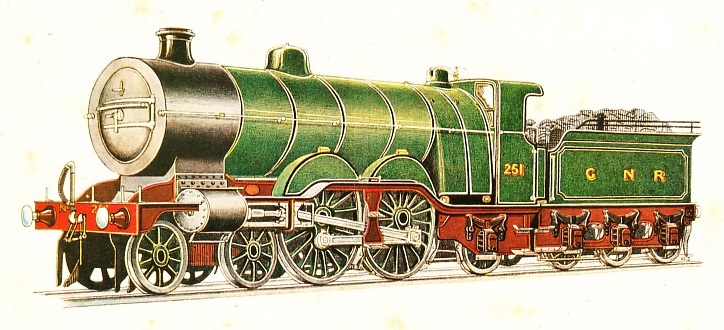
GREAT NORTHERN RAILWAY EXPRESS PASSENGER LOCOMOTIVE, No. 251
DESIGNED BY Mr. H. A. IVATT, M.INST,C.E., M.INST.M.E.
THE Great Northern is the first link in the East Coast route to Scotland; and, by means of its own lines, joint lines, running powers and agreements, its working area extends not only over the Border but westward to Liverpool and eastward to Cromer -
The first railway to Yorkshire was projected by those great company promoters, the Rennies, in 1827. Two years before, they had proposed a line up the valley of the Lea to be continued on to Cambridge; their York line was merely the prolongation of this through Lincoln, and their scheme failed to please and came to nothing.
The real beginning was made in 1835, when Joseph Gibbs, better known perhaps in Brighton matters, apparently on his own account surveyed a route of what he called The Great Northern Railway, the Bill for which was thrown out by the Commons in the following year. Undismayed, Gibbs kept the project alive, and being a busy man he could afford to wait. Eight years went by of scheming and inquiring on the part of other projectors, and in April 1844 there came out the prospectus of another company, the Direct Northern, which was followed a month afterwards by that of the London & York.
Between these companies there were desperate contests, parliamentary, financial, and more or less disgraceful, but it seems a wearisome business to us now, and all that need be said is that after leading one another a terrible time they amalgamated. The London & York absorbed the Great Northern on the 17th of May 1844, and the Direct Northern on the 5th of May 1846, and Gibbs’s title, which had been dropped at the first amalgamation, was revived at the second, the united companies becoming the Great Northern Railway, which obtained its Act on the 26th of June 1846.
Not only did the company get its name from Gibbs, but it got its main road. He should have been the engineer, but apparently for Stock Exchange reasons -
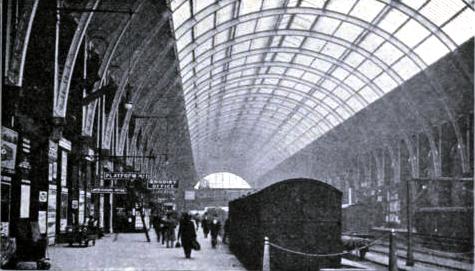
NO. 1 DEPARTURE PLATFORM AT KING’S CROSS
Locke did little more. He only held office for a few months, his resignation being dated 17th of September 1844. He was then away in Paris on French railway business, and the letter did not arrive until three days afterwards; it was a severe blow for the young company, and required to be acted on instantly. Edmund Denison was quite equal to any such emergency. Very late that Friday night he drove over to William Cubitt’s house on Clapham Common. It was all in darkness, and Denison knocked for some time without arousing anybody. Then at a first-
The Act authorised the making of 327 miles of railway, of which 186 were to form the main line to York, and Cubitt, assisted by his son Joseph, soon became busy. In November 1846 Thomas Brassey was asked to contract for the section between London and Peterborough, while in January Morton Peto was given the contract from Peterborough to Gains-
The bridges also were made in a special way. “They were intended to be piled,” says Ballard. “ The peat was 22 ft deep, and I pointed out to the engineer the difficulty of sufficiently bracing the piles, their tops being only about 3 ft above the soft bog. The piling was given up, and we made rafts of timber on which brick walls were built. These gradually sank, care being taken to so dispose the weight as to keep the walls perpendicular, and finally the walls were tested with rails of a greater weight than that of any train that could pass over them. We did not load too quickly, but left it; we put a little load on, and left it; and then the water had a chance of escaping. only compressed the peat beneath the raft, without displacing it, for if we had once displaced it we must have gone down to the solid.”
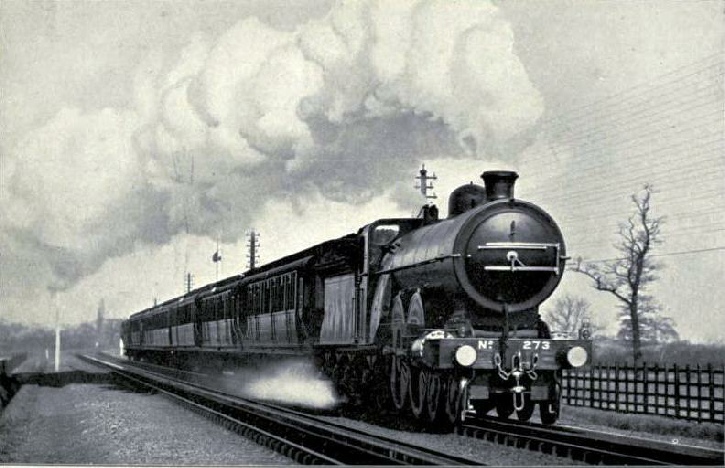
AN EAST COAST EXPRESS PICKING UP WATER AT FULL SPEED
Brassey was much hindered by the failure of the Great Northern people to make the agreed payments on account and he took the company’s bonds in lieu of cash, as also did Ballard, who was paid by a share of the profits. Ballard had to sell his bonds at a loss, but the company afterwards honourably made good all the loss he had sustained. Thus the building of the line went on, Brassey making no claim for the delays occasioned by these financial difficulties, -
On the 1st of March 1848 the first section of the Great Northern was opened for traffic. Of all places on the system it was the thirty miles between Louth and New Holland! And of this only fourteen miles belonged to the Great Northern, the rest being owned by the Manchester, Sheffield & Lincolnshire. The next was the 4¼ miles from Doncaster to Askern, the next that from Louth to Peterborough. The section from Maiden Lane -
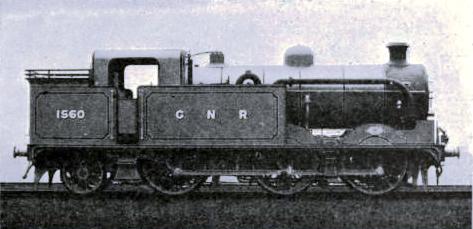
A POWERFUL TANK-
Anyhow, it was the cheapest of the existing London terminals; and for the 13 trains out of it a day, 3 fast and 10 slow, it was large enough. There were two long platforms, arrival and departure, and between them were 14 tracks. The two sheds were, and are, 800 ft long, 105 ft wide, and 71 ft high. The idea of the roof was borrowed by the architect, Sir William Cubitt’s nephew, Lewis Cubitt, from the riding-
The line was thoroughly good, like all Sir William Cubitt’s lines, and, like all of them, it was laid out for fast running. Unlike the South Eastern, its capacities in that respect have been utilised to the full. It was built for speed and it has been used for speed; but it should be remembered that the Great Northern’s business really began north of Grantham where the M. S. & L. came in, and that it was best to get over the intervening distance as soon as possible. That stretch of 105 miles was practically a line of approach along which much was gained by saving time. Farther north up to Doncaster the trade thickened, and Doncaster is really the end of the main line. Peterborough did not become of importance until the company’s good habits had become second nature. It was the evident advantage of getting to work quickly that led the Great Northern to adopt speed as a policy from the very early days, and the reason still holds good. Speed may, or may not, pay everywhere, but it certainly has paid and does pay on the King’s Cross route.
The line has no gradients or curves of importance. It rises to Holloway at 1 in 110; then comes a gentle rise to Hornsey, followed by a long rise of 1 in 200 from Wood Green to Potter’s Bar. Then the profile goes down to Hatfield and up to Welwyn along the great Digswell viaduct of forty arches that carries the line 89 ft above the Mimram, then through the tunnel of the three trains and up and down to Stevenage; the descent to Arlesey follows, and on to Peterborough there is nothing to trouble about. Beyond Peterborough the line rises until at 1 in 178 it attains 347 ft at Stoke between Corby and Great Ponton, from which at 1 in 180 it descends to Grantham. Altogether there are twenty-
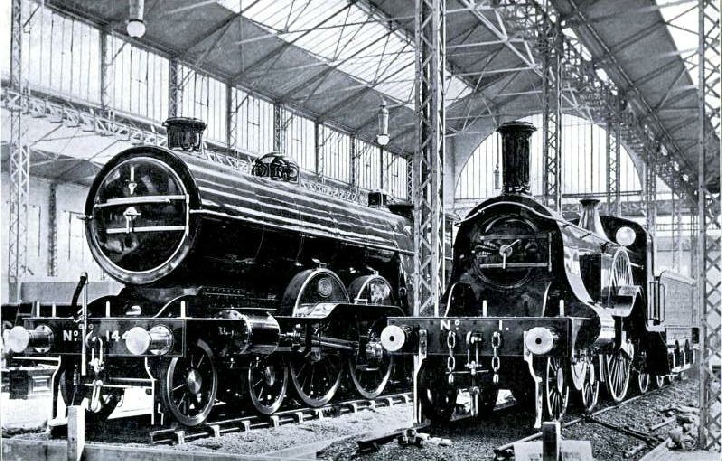
PAST AND PRESENT -
“The Great Northern Railway,” said Edmund Denison, the famous chairman of the company, “ends in a ploughed field four miles north of Doncaster.” That ploughed field was, however, not at Shaftholme Junction, as generally reported. It was at Askern Junction, 4 miles 26 chains north of Doncaster, that is a dozen cricket pitches farther north than Shaftholme, and a little to the west of it, that the Great Northern joined end-
From Peterborough goes off its joint line with the Midland which takes its trains to their farthest east at Lowestoft. At Werrington, just beyond Peterborough, begins the Lincolnshire loop which extends up to Grimsby, and takes in Skegness, Mablethorpe, and Lincoln. From Grantham goes its short road to Lincoln, whence it proceeds along its joint line with the Great Eastern which runs from Somersham to Black Carr; and also from Grantham goes off the western branch leading to Nottingham and Derby, and as far as Egginton Junction, whence the North Stafford takes on the Northern trains to the Northern outlier beyond Uttoxeter. From Retford, Sheffield and Manchester are reached by way of the Great Central; another route to Manchester being over the Cheshire Lines, which from both Manchester and Stockport lead on to Liverpool.
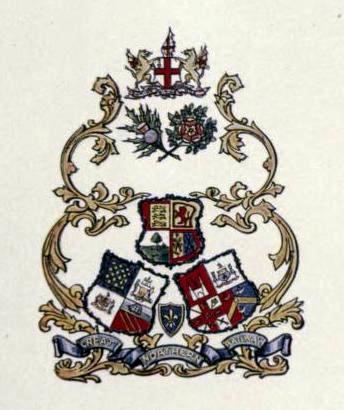 At Doncaster matters are more complicated. No less than six other companies run in, these being the Midland and North Eastern, which have their own booking-
At Doncaster matters are more complicated. No less than six other companies run in, these being the Midland and North Eastern, which have their own booking-
Coming up from the south is the Great Northern main line. At Black Carr Junction there runs in from the east the Great Northern and Great Eastern Joint from Somersham. At the South Junction comes in from the west the Great Central from Swinton, to leave on the east at the North Junction, that is Marsh Gate, for Grimsby. Farther north the West Riding Joint crosses at a right angle from Adwick to join the Great Central where the North Eastern line comes in from Hull. Just beyond this is Shaftholme Junction, where the North Eastern comes in from York; and a little farther on, bearing off to the west from Shaftholme, is Askern Junction, where the Lancashire & Yorkshire joins. Just outside Doncaster station, at North Junction, there goes off to the left the West Riding Joint, owned by the Great Northern and the Great Central, which leads to the Great Northern island in the Wakefield district, from which its trains get as far as Keighley which they enter on Midland metals. In fact Doncaster and Peterborough are the chief Great Northern junctions, and in the early days fierce was the struggle as to which of them should be the site of the locomotive works.
Boston was used temporarily to commence with, but was too much out of the way, and the final decision was in favour of Doncaster, as being nearer the coal and iron districts, and nearer the centre of the system in the plans of development at headquarters which were not destined to be carried out. The buildings were begun in 1853, and the works completed in 1854, the locomotive works being then near the station, the wagon works being at Carr, two miles down the line. Nowa-
For twenty-
6-
The successor of Benjamin Cubitt was Edward Bury, the head of the engine-
He bought four 4-
In April 1850 the company advertised for a new superintendent, and out of 31 applicants the choice fell on Archibald Sturrock, Daniel Gooch’s manager at Swindon, really the head of Swindon, for Gooch only put in an appearance there about once a month after it was in working order. Sturrock was born in 1816, and lived until he was well over ninety. During his apprenticeship at Stirling’s East Foundry at Dundee he helped to build the Trotter delivered to the Dundee & Newtyle in March 1834, one of the curious engines of the Earl of Airlie type, with a rear bogie and 11-
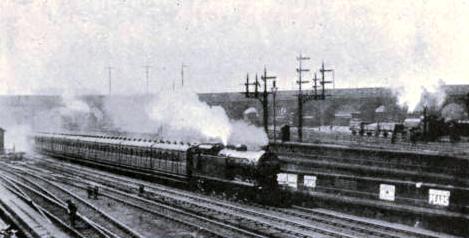
A SUBURBAN TRAIN LEAVING KING’S CROSS
With two such men, both young, the Great Northern was in fine form for its London opening. Sturrock had seen at Swindon that what the locomotive wanted was a bigger firebox and greater boiler pressure, and he began by designing engines in which instead of 80 lb he used 150 lb, but, acting on Brunei’s advice, he kept it quiet, so that nobody took alarm. Before these were on the rail he had much overhauling and rebuilding of the old stock to do, and several engines to receive that had been ordered before he took over. Among these were ten Cramptons built by Longridge which were practically the same as the Folkestone belonging to the South Eastern, having inside cylinders and a dummy crank axle with outside cranks coupled to the large driving wheels near the firebox. It was one of these engines which took the first train from King’s Cross at the opening of the London terminus in October 1852. Sturrock rebuilt the Bury and Fairbairn goods and added 3 ft trailing wheels, fitting a tank and bunker so as to do away with the tender; and he converted the Cramptons, which lasted for years afterwards with 15-
Sturrock’s first engine of his own design was No. 71. There were twenty of this class, all built by Hawthorns. Their cylinders were 16-
One of them drew the first royal train on the Great Northern. The first time Queen Victoria went by the line to Scotland was on the 27th of August 1851, when she went from Maiden Lane, then the London terminus, to Doncaster, and stayed the night at the Angel, leaving there before nine in the morning for York, to proceed by the York, Newcastle, & Berwick to Edinburgh. Beyond Stonehaven there were then no railroads, and from that principal port of Kincardineshire she had to drive all the way to Balmoral. In 1854 the journey was again made on the Great Northern, as it was every year after that up to 1861. The Prince Consort died in the December of that year, and ever afterwards the Queen went by the West Coast route.
Mention must be made of another class of handsome engines, the Large Hawthorns. These were of the 2-
6 ft 6-
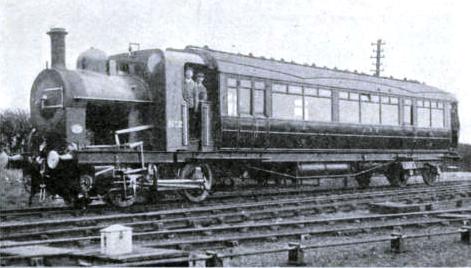
A RAIL MOTOR-
Also built by the Hawthorns was Sturrock’s No. 215, an engine of the greatest importance, designed to run from King’s Cross to Edinburgh in eight hours. She was put on the rail in August 1853, and was at once noticed as having a Great Western look owing to the absence of a dome, the shape of the firebox, and the curving of her frames over the driving axle. She had a leading bogie, being a 4-
Let us take her for the moment as being notable for her driving wheels; the next engines we must mention were notable for their leading wheels. These were the fine, powerful class Nos. 229-
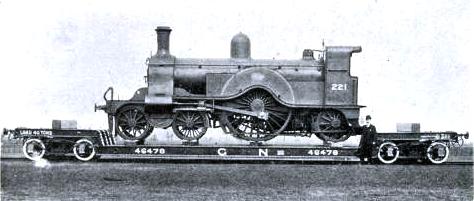
CROCODILE TRUCK CARRYING A STIRLING 8-
This engine record must now be shunted for a short space to clear the track for Sturrock’s triumph. It had been arranged that the Great Northern should work their own underground traffic on the Metropolitan on and after the 1st of September 1863. That line had been opened in January of that year; it was laid with the mixed gauge in order that the Great Western trains might run through to Farringdon Street; and, as a matter of fact, all the trains were broad-
From the first the Great Western seemed to look upon the line as their own private property, whereas Mr. Myles Fenton, the Metropolitan general manager, thought otherwise, and the result was unpleasantness that culminated in a storm. The Great Western people, thinking they had him at their mercy, gave him summary notice that in ten days’ time, that is on the 9th of August 1863, they should withdraw their rolling stock and leave him without any engines or carriages to work his line with. They had mistaken their man; and they had not thought of Mr. Sturrock.
Fenton hurried off to King’s Cross and Euston and told the story, and the Northern and the North Western at once offered to help him so far as carriages went, but with regard to engines it was a different matter, for the Metropolitan’s Act forbade any being used on the line that did not consume their own smoke and condense their own steam. In preparation, however, for the 1st of September, Sturrock had ready a few he had specially built and he turned all Doncaster on to adapt others. “They shall be ready on the 9th,” he promised.
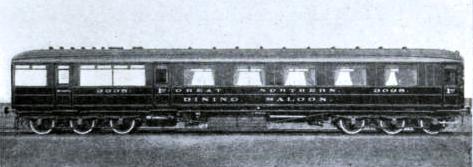
FIRST-
By flexible pipes -
It was Mr. Sturrock who endeavoured to make the tender something more than a dead weight by fitting it with an auxiliary engine. He coupled its wheels, put in a crank axle, and worked this by cylinders hung underneath the body which received their steam from the boiler. These “steam tenders” were used on the coal and goods trains for some time, and are reported to have been efficient but too costly in working and repair to be continued with. His last engines were Nos. 264-
The next chief at Doncaster was Patrick Stirling, who was born at Kilmarnock in 1820. He began at Dundee, then he went to the Vulcan, then to Neilsons, then he was locomotive superintendent of that very little line the Bowling & Balloch, then he was at Hawthorns, and in 1853 he became locomotive superintendent of the Glasgow & South Western, spending thirteen years in his native place before he moved on to Doncaster, to remain there in command for twenty-
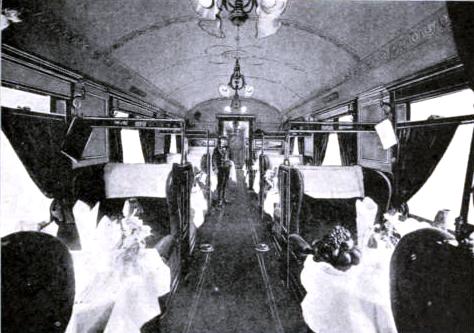
DINING SALOON OF THE EAST COAST EXPRESS
He had ideas of his own about railway engines, and he built the best looking that were ever put on the rail. That being a matter of taste, it cannot be disputed. There is no mistaking a Stirling engine. There is nothing clumsy about it. Graceful and powerful, and above all things workmanlike, with nothing spoiling the beauty of its lines, it is the very embodiment of speed. It is perfectly proportioned; nothing is unduly developed; there is no feature that is too large for its position. His engines came at that happy period when the power that was wanted was exactly such as could be provided by a machine in which no detail had to be unduly prominent, though even then there were things on the rail such as provoked old Beyer’s exclamation, “Ach, anything vill for a locomotive do!”
His first Great Northern engine was No. 280, one of a class of twenty whose numbers ended with 299. This was a 2-
The direct line from Doncaster to York through Shaftholme was about to be opened, and there was to be an acceleration of speed on the East Coast route. Some such engine was wanted; and it came out in 1870, the year of the opening. So successful was the new engine that so long as he remained at Doncaster, that is for the rest of his life, his 8-
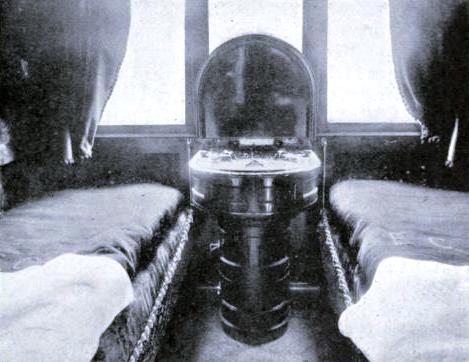
A DOUBLE-
They had outside cylinders, and these were 18-
The boiler was 4 ft 2-
The trailing wheels were 4 ft 6-
It was during the race to Edinburgh in 1888 that those who had not travelled by the Great Northern learnt what these engines could do. On the 1st of November 1887 the East Coast partners had begun carrying third-
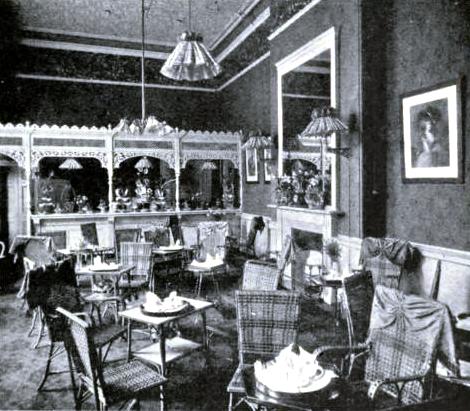
THE TEA ROOM AT KING’S CROSS
This woke up the West Coast partners, who placarded Euston on the 27th of July with bold advertisement that on the 1st of August they would deliver their passengers in 8½ hours, and they did it. But the four days’ notice was fatal, and, the very afternoon the posters appeared, King’s Cross and York took counsel together, with the result that the day the West Coast reached Edinburgh in 8½ hours the East Coast was there in 8. Thereupon the West Coast arranged to be there in 8 hours, beginning on the 6th of August, and they got there eight minutes before time, but with four carriages only, while the East Coast were punctual with their ordinary load, which was much heavier, but not double as heavy, though their carriages were twice as many. This dead heat business was not good enough for the East Coast, and so on the 13th of August they reduced their time by a quarter of an hour, after due announcement, which gave the West Coast a chance to do their very best and get there in 7 hours 38 minutes. Next day the East Coast replied by keeping time at all their stopping stations, as if nothing out of the ordinary was on, and reaching Edinburgh in 7 hours 32 minutes. That settled the matter; there was no more racing after that; and the result of it all was that the East Coast instead of getting to Edinburgh in 9 hours went there in 7¾ hours, and the West Coast instead of taking 10 hours took 8 hours, for which every one going north was duly grateful.
The Great Northern engines took the trains to York, and the North Eastern engines continued the running to Edinburgh. All through the month the Scotsman stopped at Grantham for one 8-
In June 1895 the East Coast were taking their 8 p.m. train from King’s Cross to Aberdeen in 11 hours 35 minutes, when the West Coast announced that to make sure of a connection with the Great North they would quicken their 8 p.m. train so that it should reach Aberdeen in 11 hours 40 minutes, just five minutes behind the other.
The East Coast took this as a challenge, and replied by knocking off a quarter of an hour from the journey on and after the 1st of July. As Aberdeen was a Caledonian preserve which the North British only entered by running powers on the Caledonian from Kinnaber Junction, 38 miles 22 chains to the south, there was nothing surprising in the West Coast hastening to reply by arriving there on the 15th of July in 11 hours; but it was a foolish thing to do as the East Coast route was by 16 miles the shorter.
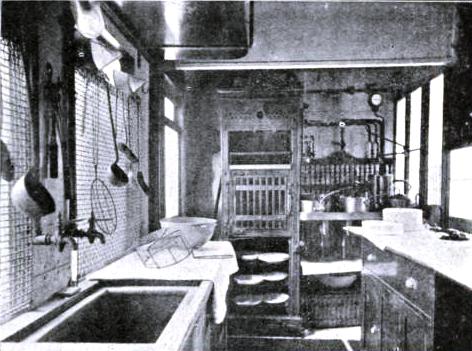
THE KITCHEN OF A RESTAURANT CAR
At the end of a week the East Coast altered its timetable and proposed to be there in 10¾ hours. Then quite a new policy was adopted by the West Coast. Bearing in mind what had happened in the race to Edinburgh, they ignored their timetables altogether and, treating the train as a private special, they concentrated their efforts on accomplishing the journey in a shorter time than their rivals, irrespective of their announcements, so that in the end their train booked to reach Aberdeen at 7 a.m. was actually there at 4.55. The East Coast were some weeks before they fully grasped what their opponents were doing; and it was not until the 19th of August that they really began to race in the longest railway race that ever took place in these islands.
It was on the 16th of August that the East Coast announced that on and after the following Monday their train would take 9 hours 40 minutes on its journey, this being 19 minutes better than the West Coast had done up to then. Great was the excitement that Monday night at both Euston and King’s Cross. The 8 p.m. North Western went off amid cheers to reach Aberdeen according to the time-
It had lost two minutes by checks at Hatfield, Welwyn, and York, and five minutes by a signalman’s error at Eryholme, and these it had made up; and when it reached Dundee it was again stopped for six minutes because it was before time. Thus it came about that the West Coast was first past Kinnaber. The North Eastern and the Great Northern forcibly protested against the treatment of the train at Waverley and Dundee, and with great difficulty managed to drive the idea into the head of the North British; and next night the train left Edinburgh as soon after its arrival as the passengers could be got in and the North British engine put on. The North Britishers did their duty well, and Dundee was as quick as Waverley, but, as the East Coaster passed Montrose, away in the west could be seen the steam of the rival which by less than a minute got the line clear at Kinnaber and led the way to Aberdeen.
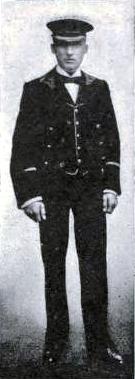
This would never do for the Great Northern, and, with No. 668 in front, as on the Monday and Tuesday, the train out on the 21st of August meant real business. Peterborough, 76¼ miles, was passed in 72 minutes; Grantham, 105¼ miles, was reached in 101 minutes. Another 8-
A CAR ATTENDANT
The time that settled the matter was not, however, the shortest, for on the following night, that of the 22nd of August, the West Coast train, cut down to its lightest, made “an exhibition run” and accomplished the journey in 8 hours 32 minutes, being 8 minutes less. Throughout the contest the East Coast carried the heavier load; on the 19th this consisted of six large E.C.J.S. coaches and an 8-
As it was at Edinburgh and Aberdeen, so it had been at Manchester in 1857, when the rival trains used to race to London Road Junction and the first to get there had the right of way. In this case the Great Northern were the partners of the Manchester, Sheffield, & Lincolnshire, and the competition became so keen that the North Western actually took people into custody for coming by the Sheffield trains, until they arrested a lawyer who made them pay for their exuberance and put a stop to it.
According to Mr. Denison the M. S. & L. had painted up their names, and the North Western “being in possession, which is nine points of the law, swept them out with their brush. They kept a truck standing in front of the platform, and left timber trains in front of our express trains. They turned our clerks out of the booking office -
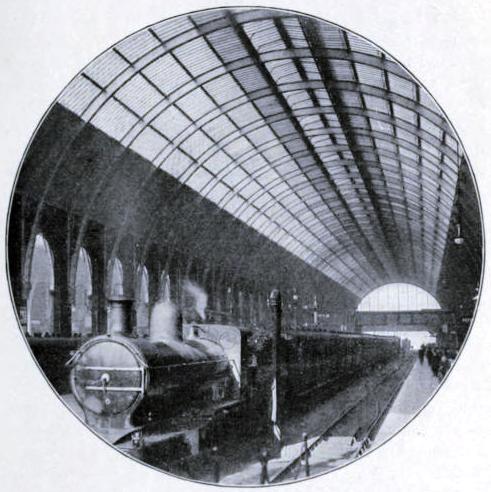
THE MAIN LINE ARRIVAL PLATFORMS, KING’S CROSS
This was only one incident in a war of rates and sundries which ended in the partners running to and from London the best train known in England. By this train, faster than the Scotsman, the King’s Cross route to Manchester, 203 miles, was travelled in quicker time than the North Western’s 189 and the Midland’s 191¾, and this over the trying gradients from Grantham onwards. But from Grantham the work was that of the partner now known as the Great Central.
Another incident of which some mention should be made was the arrival of the first Great Northern engine at Nottingham on the 1st of August 1852. The Northern engine had brought in on the old Ambergate line a train of passengers from King’s Cross when the Midland resolved to seize it. Accordingly several Midland engines were manoeuvred about until they converged on it in front and rear, and though the driver did all he knew, the Great Northern engine was hauled and pushed, and finally pushed slowly and ignominiously into a disused shed, where the rails at the entrance being pulled up it remained a prisoner for seven months while the lawyers argued the matter out, to the inevitable result that as the engine had a right of entry it had a right of departure; and the Northern has gone to Nottingham ever since.
In the autumn of the race to Aberdeen Mr. Henry Alfred Ivatt, the locomotive superintendent of the Great Southern & Western (who had received his professional training on the London & North Western) was appointed chief at Doncaster. He took up his new duties in March 1896, and at the latter end of that year brought out his first engine, No. 400. This was the first 4-
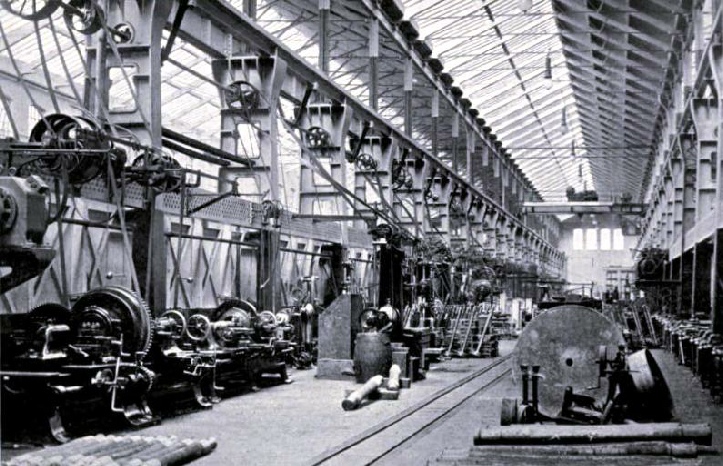
DONCASTER WORKS -
The heavy corridor stock which was being introduced in the chief express trains frequently necessitated the use of two engines on a train, and to curtail this expensive method of haulage Mr. Ivatt brought out, in 1898, a type of express engine which had not been seen on British railways before. This engine (No. 990) runs on 10 wheels, and is of the well-
Owing to the ever increasing weight of the fast trains, and the demand for high speed for long distances without stopping, Mr. Ivatt designed and built at Doncaster in 1903 an engine of the same dimensions as 990 but fitted with a much larger boiler, the diameter of the barrel being 5 ft 6-
In 1905 the directors decided to ascertain whether any of the locomotive builders could supply an express engine suitable for the conditions on the Great Northern and capable of doing better work than those already on the line. The engine proposed by the Vulcan Foundry, Newton-
The development that has taken place in locomotive building was clearly shown in the 1909 Exhibition at Shepherd’s Bush, where, side by side, stood Mr. Stirling’s first 8-
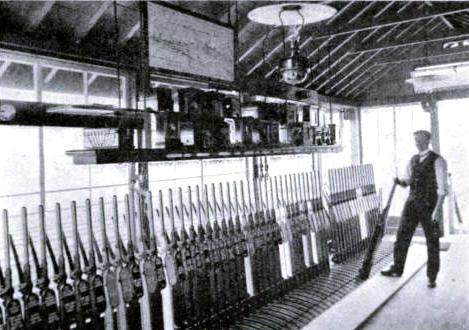
INTERIOR OF LOVERSALL CARR SIGNAL BOX
Doncaster was an excellent place to be shown the sights at some years ago, and it is so still. It is not too large, and there was plenty of daylight in the shops. There was the massive lathe for turning the big driving wheels with its face-
It is the St. Leger -
To begin with, all the sidings are cleared and no goods train is allowed on them during the four days except for an hour or two in the dead of night. The block sections are divided into halves by temporary signal-
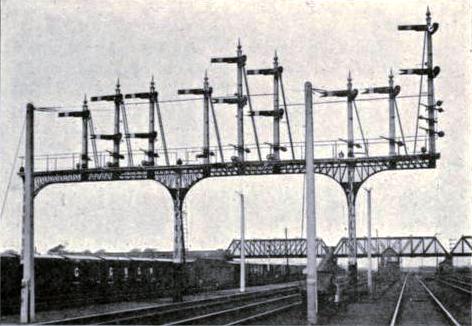
A SIGNAL GANTRY -
As each train arrives to take up the exact position marked out for it, each of its passengers is given a printed notice telling him the number of the train, which is conspicuously placarded, the position of the train on the sidings, and the way to reach it, and also the time of its departure, which is kept to the minute. The place is like a vast showyard with its big numbers and notices and the handbills in the people’s hands. From north, south, east, and west the trains run in, and every engine stops at its mark, and then from its carriages pour its five hundred or more, perhaps its thousand, passengers to stream into the throng that is on the way to the moor.
The first departure is at a quarter to six, and long before then the early trains have begun to fill. Larger and larger grows the hurrying crowd that swarms all over the tracks, almost every man with his handbill in his hand. To the minute off goes the first train, and, at intervals so short that there is not a moment in which a train cannot be seen on the move, off go the others in succession, diverging in six different directions. In one week, we may as well be exact, there were 49 excursions on the Tuesday, 173 on the Wednesday, 47 on the Thursday, 69 on the Friday; and on each of the four days there were some 180 trains worked from the station. These 1065 trains in the four days move off like parts of one machine, there is no slowing or stopping at the points, once a train begins to move it goes on faster and faster until it is out of sight ; and they scatter to every point of the compass without a check. If you want to see what can be done by organisation taught by years of experience, go to Doncaster on the St. Leger Day.
Next to Doncaster the most important junction on the line is Peterborough, which is the real centre of the system. Every day there pass through that station over a thousand trains, passenger and goods, of which about three-
Peterborough has 50,000 wagons on its books for merchandise, bricks, coals, iron, and cattle. For the cattle there are the docks by the side of the line that pass in and out some 65,000 head a year, and generally look as though used but once before they are whitewashed. South from it stretch the Fletton brickyards, where bricks are made by the million, every million weighing 2400 tons. Of coals there come to Peterborough 10,000,000 tons to be distributed. To marshal all these wagons there are the New England sidings, where there is standing room for 5000 of them at a time. There are sixty tracks side by side, and looking across them when they are busy is like looking over a vast lake of coal. Here and there you see some of the new 15-
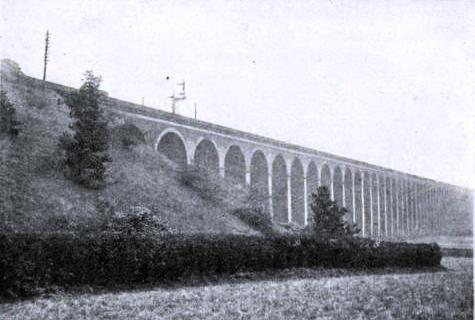
THE DIGSWELL VIADUCT AT WELWYN
At Peterborough the Great Northern has its sheet stores. Here all the tarpaulins, wagon covers, dray covers, and ropes are made, 35,000 sheets being kept in stock and 300,000 yards of canvas used in a year. Hundreds of tons of boiled linseed oil are annually absorbed, and by no means so much by weight of vegetable black, which is one of the lightest things you can lift, but let us say a suitable measure of it. The sheets are laid out on the floor like well-
The 50,000 wagons on the Peterborough books are largely in private ownership, the whole of the wagons and coaches belonging to the company numbering about 43,000, the engines, which travel about 23 million miles a year, being about 1300. These deal with some 5 million tons of miscellaneous merchandise and 16 million tons of coals and other minerals. The passengers are about 37 millions yearly, and the line is 850 miles long; but, as we have already shown, it is of much more importance than its mileage would indicate. In one respect the Great Northern differs from all our great railway companies. It has no steamboats; but it has docks at Boston, and leases the Nottingham Canal that was made in 1792 and the Grantham Canal that was made the year after, besides the Witham, and a half share in the Fossdyke which was made by the Romans and enlarged in the reign of Henry the First, and is the oldest canal in England.
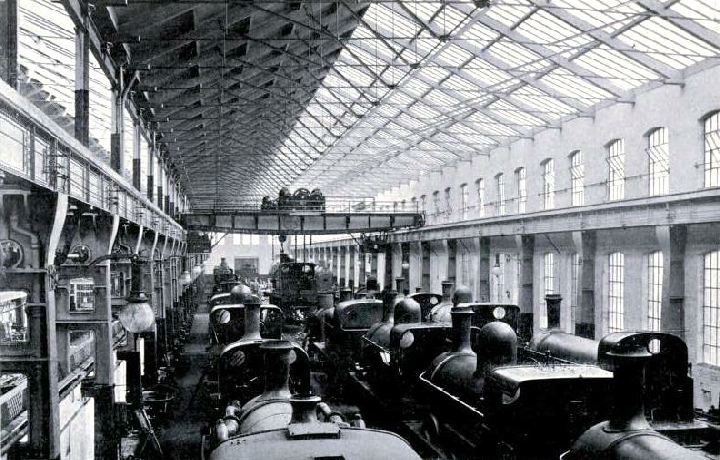
ENGINE REPAIR SHOP -
When the line was opened it introduced the best third-
The ordinary express coaches are 64 ft long; those of the East Coast Joint Service are 65½ ft; and the King’s Saloon of the Royal Train is 67 ft. This is a complete little flat on wheels, designed so as to give a wonderful amount of accommodation. Carried on two 6-
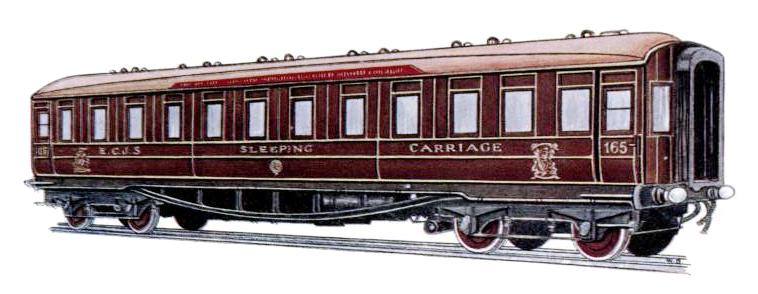
EAST COAST JOINT STOCK -
The body is of teak. The smoke-
Among the “wagons of all kinds not used for passengers” the longest would seem to be the so-

THE DINING-
Railway companies do not make so much money as they did, nor are they likely to do so. Corridor cars, catering cars, and so on, are all desirable for non-
As with the passengers so with the goods. In the old days of leisurely delivery the orders were large in order that a stock might be kept by the dealers. Nowadays the railways have so improved their services that goods collected at night are delivered next morning with almost the certainty of letters. The result is that whereas the dealer used to order in tons he is now contented with hundredweights, and the packages that have to be handled and booked are twenty times as many. The men behind the scenes in railway work have to be more numerous every year; and the net profit suffers. It is the penalty of efficiency.
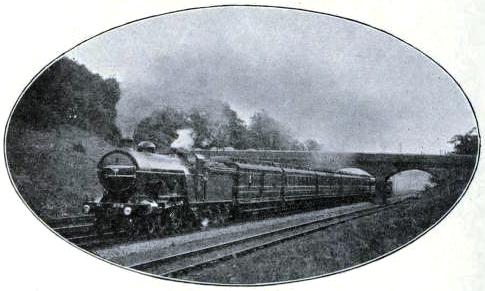
AN EAST COAST “FLIER”
You can read more on “The Great North Road of Steel”, “The North Eastern Railway” and “The Romance of the LNER” on this website.